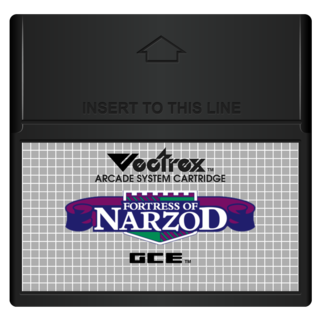Fortress of Narzod for Vectrex
VectrexGame controls in browser
Show Controller & SystemClick on the play vectrex game now button first to load the game into emulator. Control keys:
Fortress of Narzod
Online version of Fortress of Narzod for Vectrex. Fortress of Narzod is an arcade shooter for one or two players, developed in 1983 by General Consumer Electronics for the Vectrex system. The player controls a hovercraft on its ascent up a mountain range with the goal of reaching the fortress at its summit. Each screen is part of a roadway, which is defended by three waves of guardians. These waves of guardians consist first of the Doomgrabbers, then the Tarantulas and finally the Ghouls. Each wave makes its descent down the roadway and towards the player, which all of one wave needs to be destroyed before the next wave begins its descent. Contact with enemies or the Spikers which are randomly released from the Doomgrabbers will result in the loss of a life...
Game details
Other platforms online
Fortress of Narzod is currently playable only in version for Vectrex.72%
rating (2 users voted)
Covers - Box Art
Vectrex console
Online emulated version of Fortress of Narzod was originally developed for Vectrex,
a vector display-based home video game console – the only one ever designed and released for the home market, developed by Smith Engineering.
It was first released for the North America market in November 1982 and then Europe and Japan in 1983. Originally manufactured by General Consumer Electronics,
it was later licensed to Milton Bradley after they acquired the company. Bandai released the system in Japan.
The Vectrex, in contrast to other video-game systems available at the time, featured an integrated monochrome CRT monitor and did not need to be hooked up to a
television set as it provided its own built-in display. A detachable wired control pad was mounted at, and could be folded into, the lower base of the console.
Games included translucent color sheet overlays that could be placed over the monochrome screen. A number of peripherals were produced,
such as a pair of 3D goggles known as the "3D Imager" and a "light-pen" that allowed the player to draw directly on the screen.
A built-in game, Mine Storm, was playable without inserting a cartridge.
Technical specifications: CPU: Motorola 68A09 @ 1.5 MHz, RAM: 1 KB (two 4-bit 2114 chips), ROM: 8 KB (one 8-bit 2363 chip), Cartridge ROM: 32 KB, MOS 6522 Versatile Interface Adapter (VIA), Sound: General Instrument AY-3-8912, MCU controlled sound, 3-inch electrodynamic paper cone speaker;






